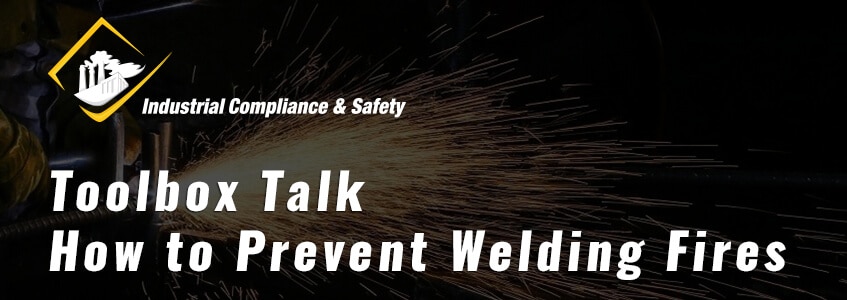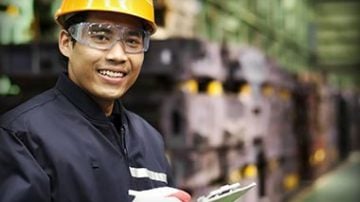Date: ____________________________________
Supervisor: _______________________________
Company Name: _____________________________
Job Name: ______________________________
Download This Toolbox Talk As A Printable Document
Looking for a PDF downloadable version for you to print off for your employees? We've got printable versions here for all of our Toolbox talks if you sign up for our newsletter!
Welding is a dangerous job. No matter how experienced a welder is, he still is working with extreme temperatures, hazardous fumes, and flammable materials. According to a study conducted by the Bureau of Labor Statistics in 2015, more than 500,000 workers are injured every year due to welding accidents. This is not a small number. Although welding can cause a large array of accidents and injuries, there is nothing more catastrophic than fire. In this week’s Toolbox Talk, we’ll take a look at welding fires and some effective strategies for their prevention.
Guidelines for Discussion:
If you have worked for a while as a welder, you have likely experienced at least one minor injury or near miss while welding. It probably isn’t difficult for you to imagine the different ways that welding can cause a fire. Sparks, hot slag, and flames from the welding torch can easily spread and create fires. If you’re working in an unprotected area, sparks can be carried by the wind, spreading fire anywhere in the worksite. Slags can fall on materials or surfaces below the welding site. And, a welding torch flame can ignite any surface it touches.
Before you weld:
- Do not work in an area with flammable liquids without consulting your supervisor.
- If you are welding a tank or drum that has contained flammable liquids or gas, don't start your work until an approved test shows that there's no danger of vapors present. Do not trust the results of a previous test - conduct a new test for vapors before welding.
- Check the surrounding area for flammable materials. Remove wood, paper, and combustibles from the area around the weld site.
- Prepare your weld site by keeping an extinguisher nearby. This can be a fire extinguisher, water, or sand. Additionally, you can ask a coworker to stand guard while you weld, holding an extinguisher in case of emergency.
Proper setup of welding equipment:
- Fully uncoil the hose and keep the cylinder as far as possible from the weld site.
- Welders should setup the tank and hoses behind them. If tanks and hoses are in front of the welder, they can be struck by sparks, slag, or flame and start a fire.
- Protect all hoses so that they aren’t damaged from surrounding worksite traffic (including trucks, coworkers, or moving materials). Place the hoses strategically so they do not pose a tripping hazard to surrounding workers.
- Wear all requisite PPE, and inspect it before use for any damaged surfaces. Remember, you and your clothing are combustible, and you can be the object to ignite a fire.
How to handle flammable floors:
- If you’re working in an area where the floor is combustible, cover the floor with fire resistant material so that it is protected from hot slag.
- In some cases, like with wooden flooring, you may consider wetting the floor. However, remember that water adds a shock hazard. This is especially important to remember if you are arc welding.
- Scan the floor for cracks or holes, and seal any found openings. Sparks or slag can fall into these openings, causing damage in the hidden areas between walls and floors.
- Protect openings and doorways with a non-combustible curtain. This curtain should stretch from the ceiling to the floor, preventing sparks or slag from rolling under or over it. If you are working in a windy area, be especially thorough when positioning the curtain.
By following the above guidelines, you can prevent most welding fires. All it takes is a thorough inspection of the surrounding area, and a considered setup of the welding equipment and flame-resistant covers. If you remember one thing, remember this: never rush into a welding job. Take the time necessary to scan and setup beforehand - it can save your life.
Disclaimer:
The information contained within this document (both the online and downloadable version) is provided for informational purposes only. Nobody shall take this as a comprehensive or exhaustive resource on this topic. This material is believed to be accurate, however, the information has been compiled from multiple sources, and so Industrial Compliance & Safety assumes no responsibility for the accuracy of this information. We encourage you to consult experts about this specific Toolbox Talk to ensure you are compliant with any and all safety regulations and processes. In no event does the content of this document supersede any applicable local, state, or federal statutes or regulations.
Safety Recommendations: _____________________
Job Specific Topics: ___________________________
Attendees:
____________________________________
____________________________________
____________________________________
____________________________________
____________________________________
____________________________________
____________________________________
____________________________________
____________________________________
____________________________________
____________________________________
____________________________________
____________________________________
____________________________________
____________________________________
____________________________________
____________________________________
____________________________________
____________________________________
____________________________________
____________________________________
____________________________________
Disclaimer
The information contained within this document (both the online and downloadable version) is provided for informational purposes only. Nobody shall take this as a comprehensive or exhaustive resource on this topic. This material is believed to be accurate, however, the information has been compiled from multiple sources, and so Industrial Compliance & Safety assumes no responsibility for the accuracy of this information. We encourage you to consult experts about this specific Toolbox Talk to ensure you are compliant with any and all safety regulations and processes. In no event does the content of this document supersede any applicable local, state, or federal statutes or regulations.





